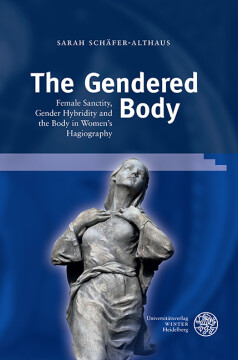
BUCH
The Gendered Body
Female Sanctity, Gender Hybridity and the Body in Women’s Hagiography
Regensburg Studies in Gender and Culture, Bd. 8
2017
Zusätzliche Informationen
Bibliografische Daten
Abstract
The (female) body was a highly controversial and much debated topic in the Middle Ages. It constantly had to negotiate its place between glorification and crucifixion, between superiority and subordination and many social, cultural and gender-related implications were closely connected to it. However, no other aspect of medieval cultural history has been more neglected within scholarship than the body, leaving a research gap in chronicles of cultural history and in the modern understanding of the past. This study investigates the complex historical, cultural, sociological and gendered constructions of the medieval female body in popular female saints’ legends. By focusing on frequently recurring body parts in women’s hagiography, such as the breast, hair(styles) and the tripartite construction of mouth, teeth and tongue, it critically reflects on the gendered treatment of these body parts against the ideological and religious background of its genre and the role of women at that time.
Inhaltsverzeichnis
| Zwischenüberschrift | Seite | Aktion | Preis |
|---|---|---|---|
| Cover | Cover | ||
| Titel | 3 | ||
| Imprint | 4 | ||
| Table of Contents | 5 | ||
| Acknowledgements | 7 | ||
| Introduction | 9 | ||
| 1 Cultural Constructions: Femininity, the Body and the Saint | 21 | ||
| 1.1 The Significance of Sanctity | 23 | ||
| 1.1.1 Hagiography: An Introduction | 24 | ||
| 1.1.2 The Cult of the Saints: Historical Development and Function | 29 | ||
| 1.2 The Body as a Metaphor: Constructing the Body | 34 | ||
| 1.2.1 Identifying the "Natural" – Identifying the "Cultural" Body | 35 | ||
| 1.2.2 Hierarchical Structures: Mapping the Body | 40 | ||
| 1.2.3 Sexuality and the Church: Controlling the Body | 44 | ||
| 2 Female Breasts – Female Weakness | 51 | ||
| 2.1 “A Complex Delight”: Illuminating the Symbolism of Breasts | 53 | ||
| 2.2 The Torture of the Breast: On Imitatio Christi, Gendered Torture and Body Fluids | 57 | ||
| 2.2.1 Saint Agatha: Serving Breasts on a Silver Plate | 62 | ||
| 2.2.2 Holy Women and Milk-Leaking Wounds | 68 | ||
| 2.3 Denying Nature: Transvestite Saints and the Concealment of Womanhood | 73 | ||
| 2.3.1 Queering the Church | 74 | ||
| 2.3.2 Saint Eugenia: Denying and Exposing | 78 | ||
| 2.4 Concluding Remarks | 84 | ||
| 3 Details that Matter: The Implications of Hair(Styles | 87 | ||
| 3.1 Gendered Cells: Hair as a Social Phenomenon | 88 | ||
| 3.2 Saint or Sinner? The Ambiguity of Long Hair | 91 | ||
| 3.2.1 Harlot Saints and Hairy Repentants | 93 | ||
| 3.2.2 Saint Agnes: The Virgin Martyr | 99 | ||
| 3.3 Challenging Nature: Transvestite Saints and the Significance of the Haircut | 103 | ||
| 3.3.1 Saints Eugenia and Euphrosyne: Manly Women of God | 105 | ||
| 3.3.2 Receiving the Holy Haircut: Patterns, Popularity and the Denial of Sexuality | 109 | ||
| 3.3.3 “But Who Can Cut My Hair?” The Function of Masculinity | 114 | ||
| 3.4 Otherness and Ultimate Violation: The Bearded Saint | 117 | ||
| 3.5 Concluding Remarks | 125 | ||
| 4 Silenced, Penetrated, Sexualized: Two Readings of Teeth, Tongues and Throats | 127 | ||
| 4.1 Cut Off – Cut Out: Symbolism, Torture and Common Practice | 128 | ||
| 4.2 “Letting Satan In…”: Silencing the Saint | 133 | ||
| 4.3 Saintly Sexualized Bodies: Pious Pornography, Symbolic Defloration and Attempted Rape | 141 | ||
| 4.4 Concluding Remarks | 147 | ||
| 5 Gender Hybridity in Women’s Hagiography | 149 | ||
| Conclusion(s): The Gendered Body and Female Sanctity | 165 | ||
| Bibliography | 171 |


 Publishing Platform by CloudPublish
Publishing Platform by CloudPublish